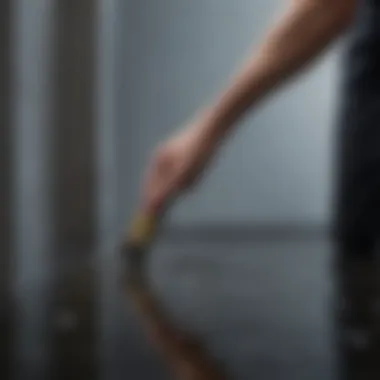Top Techniques for Cleaning Oil-Based Paint Brushes Effectively


Intro
Cleaning oil-based paint brushes is often brushed aside, leaving homeowners with a nagging feeling as they toss aside old brushes, convinced they can’t be saved. This guide aims to recalibrate that notion. Proper maintenance of your paintbrushes not only prolongs their life but also enhances the quality of your painting projects. Whether you’re a seasoned painter or just dipping your toes into the world of home improvement, understanding how to effectively clean and care for your tools is indispensable.
In this discussion, we will explore different cleaning methods, provide insights into the specific products you could use, and give special attention to eco-friendly practices that resonate with environmentally conscious homeowners.
Furthermore, we will touch on how clean tools can effortlessly influence the aesthetics of your finished work—you don't want to mix colors from a dirty brush!
Design Inspiration
When it comes to the world of design, inspiration can strike from anywhere. For those who love to paint, different design trends and color palettes play a huge part in determining choices—both in colors used and just as importantly, how to keep those colors vibrant on your tools.
Trending Styles
It’s no secret that home improvement styles evolve over time. For instance, the current trend leans towards natural and earthy tones with splashes of bold colors to add character. Think of colors like sage green, terracotta, or deep navy blue that pair beautifully with natural wood elements in a home. It’s imperative to note that these colors often require precise application for the best outcome, where a well-maintained brush shines.
Color Palettes
Understanding which colors work well together can transform a space, but the tools to apply those colors must also be in tip-top shape. Utilizing complementary shades can create seamless blends that add depth and interest. Imagine the sophisticated allure of a muted beige paired with a rich hunter green—that’s the sort of ambiance you can create when your brushes are clean and ready to work.
It’s a matter of mixing those color palettes with clarity and purpose, achieved only through well-maintained tools.
Practical Tips
Maintaining your oil-based paint brushes may sound laborious, but it can actually be straightforward and rewarding. Here are some practical tips that can guide your process:
Maintenance & Care
- Immediate Rinse: After every use, rinse your brushes promptly to prevent paint from drying on the bristles.
- Use Solvent: For oil-based paints, using mineral spirits or a brush cleaner specifically made for oil paints will work wonders. Soak the bristles for a few minutes if needed, then work the solvent through the bristles to dislodge the paint.
- Thorough Cleaning: Always finish with warm soapy water. This will ensure complete removal of any remaining paint or solvent residue.
- Shape and Dry: After cleaning, reshape the bristles gently and lay them flat to dry. Hanging them can cause the bristles to bend or fray.
Budgeting & Planning
Investing in quality cleaning products will save you in the long run. Some brushes may be more expensive, so taking the time to clean them effectively is crucial. Here’s how you can plan:
- Set a Routine: A regular cleaning routine not only helps with maintenance but encourages good habits.
- Check Supplies: Keep a stash of essential cleaning supplies handy, be it mineral spirits or natural soap, so you can clean without delay.
- Evaluate and Replace: Assess the condition of your brushes periodically. If they become matted or lose shape, it may be time to refocus your budget on purchasing new tools.
“A well-cared-for brush can perform miracles, while a neglected one might ruin your masterpiece.”
In summary, keeping your oil-based paint brushes clean is much more than just a chore—it is an integral part of the painting process that can dramatically affect your results. By following the guidelines shared above, you’ll ensure your tools are ready and waiting for your next creative venture.
Understanding the Importance of Cleaning Oil-Based Paint Brushes
Cleaning oil-based paint brushes isn't just a chore; it's crucial for anyone who values quality work in their painting projects. A well-maintained brush can last years, providing consistent and smooth application of paint. Conversely, neglecting your brushes can lead to a series of headaches down the line, such as ruined projects and wasted paint.
The Role of Brushes in Painting
Paint brushes are like the paint itself – they are vital tools in achieving the desired look and finish. Different shapes and sizes of brushes help create various strokes and effects. A good quality brush can enhance the richness of the paint, ensuring even application and reducing the chances of streaks or unintentional texture changes. If brushes aren't cleaned effectively after use, they may retain dried paint, leading to uneven application in future tasks.
Just think of it: Using a brush caked with dried oil paint can ruin the aesthetics you're trying to achieve. It's akin to sharpening a dull pencil—difficult and not yielding a clean line. Properly maintained brushes contribute to artistry and professionalism in the final outcome. Without them being clean, the role they play diminishes significantly.
Maintenance for Longevity
Like any tool, brushes require care if they are to serve you well over time. Regular cleaning extends their lifespan and maximizes your investment. A brush can be likened to a loyal companion in your design journey; take care of it, and it will stand by your side for a long time. Not only should you clean them after each job, but periodic deep cleaning is also essential—especially if the brush has been used extensively.
Here are some maintenance tips to keep brushes in tip-top shape:
- Rinse Immediately: After painting, rinse your brush under warm water to soften the paint remnants.
- Use Solvent: For oil-based paints, a solvent specifically designed for cleaning is a must.
- Store Properly: Don't just toss your brushes into a drawer; store them upright to maintain their shape.
Impact on Paint Quality
The pressure of working with oil paints can’t be overstated, and it’s easy to underestimate how bristle condition affects the final painted surface. Brushes that aren't cleaned collect paint residue that spoils not just future applications but also the quality of the paint itself. When brushes are not thoroughly cleaned, colors can unintentionally mix, leading to undesirable hues and inconsistencies in your work.


Moreover, using brushes with remnants of old paint can lead to poor adhesion of new layers. It can make the new paint vulnerable to chips and peeling over time. Just picture painting a beautiful accent wall and discovering the finish weakening in a few months. A clean brush reduces the risk of achieving a subpar outcome and enhances the durability of your work.
"Investing time in cleaning tools means investing in the quality of your completed projects."
In essence, taking care of oil-based paint brushes is not a mere task; it’s a cornerstone of successful painting. It ensures that the brushes perform effectively, contributing to the overall quality and longevity of your projects. The value of a brush well-cared for cannot be overstated, aligning with the high standards demanded by discerning homeowners and design aficionados.
Preparation for Cleaning Brushes
Cleaning oil-based paint brushes isn’t merely about making them look tidy. The preparation stage lays the much-needed groundwork for effective cleaning, ensuring that the process is not only thorough but also safe for both the user and the environment. A few necessary steps can greatly enhance the cleaning experience, including gathering the correct supplies and setting up a workspace conducive to handling materials safely.
While diving into brushing cleaning without prior setup might seem tempting, taking the time to prepare reduces frustrations later, minimizes mess, and preserves the quality of tools used in painting.
Gathering Necessary Supplies
Solvents and Cleaners
When it comes to oil-based paint brushes, selecting a suitable solvent or cleaner can make or break the cleaning process. Products like mineral spirits or turpentine are the go-to choices for most. They are effective at breaking down the thick oil paints that often gunk up brushes. The primary characteristic of these solvents is their ability to dissolve dried paint without damaging the bristles.
One unique feature of solvents is their volatility, meaning they evaporate quickly. This can be seen as a double-edged sword. This quality can make the cleaning process speedier but also means that you need to use them in a well-ventilated area to avoid inhaling harmful fumes. People have found these solvents to be incredibly effective, but care must be taken to follow safety guidelines closely.
Protective Equipment
Handling solvents essentially requires protective equipment. At minimum, wearing gloves is essential to avoid skin irritation. Additionally, using a mask when working with solvents safeguards against inhalation of toxic fumes. These items truly play a vital role in keeping you safe during the cleaning process.
The main advantage of protective gear is its ability to prevent injury while using harsh chemicals. It might seem like a hassle, but donning the right gear can boost your confidence and comfort as you tackle grime and dried paint from bristles. It is worth remembering that safety should never be an afterthought.
Workspace Setup
Ventilation Considerations
Setting up a clean, well-ventilated workspace is crucial when working with oil-based paints and solvents. Proper ventilation ensures that any fumes evaporate rather than accumulate. Lack of air circulation can turn a simple cleaning task into a hazardous endeavor, leading to headaches or more severe health issues.
The key characteristic of good ventilation is having windows open or fans running to promote airflow. If you're indoors, aim for a space close to the outside. This practice is beneficial not only for safety but also for creating a more pleasant working environment, free from strong chemical odors that may linger otherwise.
Surface Protection
Protecting your workspace surface is another important focus during the preparation phase. A lot of people forget to cover surfaces and end up with unfortunate stains or damage. Depending on your space, consider using newspapers or drop cloths as protective layers.
The unique feature of a protective surface is that it captures spills and splatters, making cleanup a walk in the park. While it might seem like just a minor step, not protecting your surfaces might lead to long-term damage, costing more time and effort than you’d like.
"Preparation is not just about the tools you gather; it’s also about creating a safe space to ensure your efficiency and effectiveness in the cleaning process."
In summary, preparing for brush cleaning isn't just a checklist; it’s a strategic approach that sets the stage for a successful cleaning. By focusing on gathering necessary supplies and properly setting up your workspace, you're ensuring that you can tackle your oil-based paint brushes with confidence and effectiveness.
Cleaning Techniques for Oil-Based Paint Brushes
When it comes to keeping your oil-based paint brushes in tip-top shape, the cleaning techniques used are of utmost importance. Effective cleaning can have a profound effect on the longevity of these tools as well as the quality of your finished projects. After all, no one wants to ruin a masterpiece because of a poorly maintained brush. Not only are there various methods to explore, but understanding the nuances of each can help ensure you are making the best choice for your needs.
Using Solvents
Types of Solvents
Solvents are often the unsung heroes when it comes to getting paint out of brushes that have been used for oil-based paints. Among the various options, mineral spirits and turpentine stand out. Mineral spirits are the most common choice due to their effectiveness and relatively low odor. They dissolve oil paints quickly and leave the brushes squeaky clean.
On the other hand, turpentine is a bit stronger and can remove the thickest layers of paint, but it comes with a more pungent smell and higher toxicity. Choosing between these options often boils down to the scale of your painting project and your comfort level with handling strong odors.
Pros and Cons:


- Mineral Spirits: Less odor, effective on most brushes.
- Turpentine: Stronger and effective on thick paint but can be harsh to handle.
Application Method
Once you've gathered your solvent, the way you apply it can make all the difference. Soaking the brush in a container filled with your chosen solvent can loosen the paint remarkably well. After a short soak, use a wire brush or a comb designed for cleaning brushes to help lift any remaining residue. This method is popular for its thoroughness, but one must take care to follow safety guidelines, like working in a ventilated area and wearing gloves.
Advantages:
- Thorough cleaning and can prolong brush life.
- Effective for hard-to-clean dried paints.
Hot Water Rinse
Effectiveness
Using hot water for rinsing brushes is another effective technique, especially if the paint is fresh. Oil paint thins easily in warm water, making it less likely to stick to the bristles. This method is beneficial for quick clean-ups when you plan to use the brushes again soon. A good rinse under hot water can save both time and resources.
Limitations
However, it’s important to note that hot water may not remove dried paint as efficiently as solvents. If the paint has had time to firmly set in the bristles, relying solely on water may not yield the desired results. In this regard, hot water acts as a supplementary method rather than a standalone solution.
Considerations:
- Best for fresh paint.
- Not effective on older, dried paint residues.
Specialized Brush Cleaners
Features of Cleaners
Specialized brush cleaners are specifically engineered to handle oil-based paints. These products usually come with natural ingredients that are designed to cut through oils without being harsh on the bristles. One popular choice is a citrus-based cleaner, which not only smells pleasant but is also effective and biodegradable. Such cleaners provide a more balanced approach to caring for your brushes and can reduce environmental impact.
Key Trait:
- Eco-friendly options that are gentle on brushes.
Step-by-Step Process
Cleaning with specialized cleaners often involves an easy, four-step process:
- Apply the Cleaner: Simply apply the cleaner to the bristles, ensuring even coverage.
- Work Through the Bristles: Gently massage the product into the bristles.
- Rinse Under Warm Water: Rinse thoroughly with warm water to remove any residue.
- Groom the Brush: Shake the brush gently and reshape it while damp for best results.
This method often leads to a more refreshed brush, extending its life and allowing for a smoother application in your next project.
Benefits:
- Gentle yet effective.
- Promotes longevity of brushes, ultimately saving money in the long run.
Cleaning your oil-based paint brushes effectively not only ensures quality results but also reflects on your dedication as a painter and craftsman. Maintaining your tools can profoundly impact your artistic work.
After-Cleaning Care
After properly cleaning your oil-based paint brushes, the work does not stop there. Ensuring that these tools are not only clean but also well-cared for after the cleaning process is essential for maintaining their longevity and effectiveness. This section highlights why after-cleaning care matters, with a focus on drying techniques and storage recommendations that can significantly influence the lifespan of your brushes.
Drying Techniques
Natural Drying
Natural drying is often viewed as the gentler method for ensuring that your brushes do not suffer any additional stress after cleaning. The key characteristic of natural drying is its simplicity: just letting the brushes air out after they've been rinsed. This method contributes positively to the brush's shape and bristle integrity since it avoids any abrasive forces or potential damage from using mechanical drying techniques.
- Benefits: The unique feature of natural drying is that it doesn’t require any extra tools or materials, making it an eco-conscious choice. Additionally, it helps maintain the original form of the bristles, preventing them from becoming misshapen. It’s a reliable method for those who want to avoid complications that might arise from high temperatures or friction.
- Disadvantages: However, one should keep in mind that natural drying can take longer, especially in environments with high humidity. So, if you’re in a hurry, this might not suit your needs.


Using a Cloth
Using a cloth for drying provides a quicker alternative. This technique involves gently dabbing the excess moisture from the bristles with a clean, lint-free cloth. Its key advantage lies in the speed of drying, allowing you to use your brushes again sooner.
- Benefits: A unique feature of using a cloth is that it eliminates the wait time associated with natural drying, making it suitable for last-minute touch-ups. Plus, it can reduce the risk of paint remaining in the bristles, which is vital to protecting the brush’s structure over time.
- Disadvantages: On the flip side, if you're not careful, you might apply too much pressure, leading to fraying or bending of the bristles. It's crucial to be gentle, as aggressively rubbing your brushes can undo all the careful work you've put into cleaning them.
Storage Recommendations
Proper Positioning
Once the brushes are dry, correct positioning for storage becomes paramount. The key element of this technique is to store brushes horizontally, or upright in a jar with the bristles facing upwards. This orientation prevents the bristles from becoming misshapen and prolongs their lifespan.
- Benefits: Proper positioning ensures that no pressure is applied to the bristles, maintaining their condition much longer. Moreover, it’s a straightforward system that requires little effort. This method also keeps brushes accessible for the next project, encouraging regular maintenance and care.
- Disadvantages: On the other hand, storing brushes improperly can lead to permanent deformation and diminished effectiveness, which negates any previous care you provided.
Environmental Considerations
When discussing storage, it is essential to consider the surrounding environment as well. Temprature and humidity can impact the condition of your brushes. Ideal storage environments are dry and moderate in temperature. High humidity can foster mold growth, while extreme dryness can desiccate the bristles.
- Benefits: A controlled environment preserves the quality of your tools, allowing for a longer horizon of usability. Storing brushes in a cool, shaded area prevents unnecessary wear from sunlight or moisture.
- Disadvantages: But, creating such an environment can be challenging. Not every homeowner has the luxury of a dedicated space for their paints and tools. Thus, some creativity might be required to find the best balance in storing your brushes effectively.
Proper after-cleaning care not only maintains the performance of your oil-based paint brushes but also significantly enhances their lifespan. Taking the time to dry and store your tools correctly ensures they are ready for your next creative endeavor.
Environmental Considerations
Cleaning oil-based paint brushes isn't simply about keeping tools in good shape; it involves responsibility towards the environment as well. The solvents and chemicals used in the process can be harmful to both the ecosystem and human health if not handled correctly. Thus, being conscious of how we clean our brushes plays a critical role in preserving the environment for future generations.
Disposal of Solvents
Disposing of solvents used in cleaning brushes is a significant concern. Many people underestimate the impact improper disposal can have. Throwing solvents down the sink or tossing them in the garbage can contaminate the water supply and soil. Instead, one should adhere to local regulations on hazardous waste disposal. Here are key points to consider:
- Check Local Guidelines: Different areas have specific rules regarding hazardous waste. Familiarizing oneself with these regulations ensures safe disposal.
- Designated Collection Points: Many communities offer collection points for hazardous materials. Utilize these facilities to ensure materials are treated safely.
- Recycling Options: Some solvents can be recycled. Investigating local resources can provide alternative methods for handling these chemicals.
"Taking the time to properly dispose of solvents reflects a commitment not only to your craft but to the planet. Every small step can lead to significant change."
Eco-Friendly Cleaning Alternatives
Switching to eco-friendly alternatives is good for both brushes and the environment. Less toxic choices minimize harm while still being effective.
Natural Cleaners
Natural cleaners are gaining traction as viable options for those conscious of environmental impact. These cleaners often consist of non-toxic ingredients such as vinegar or baking soda, which can effectively break down paint residues. Their key characteristics include:
- Simplicity: Usually made from common household items, natural cleaners are easy to obtain and create.
- Safety: They pose less risk to skin and respiratory systems compared to harsher solvents.
One unique feature of natural cleaners is their biodegradability. Unlike heavy-duty solvents that linger in the environment, these alternatives break down naturally, causing less long-term damage. However, a downside might be that they sometimes require more elbow grease compared to conventional methods.
DIY Solutions
Creating your own cleaning solutions at home can be both cost-effective and eco-friendly. DIY solutions often incorporate basic ingredients that you may already have lying around, such as olive oil or dish soap.
- Versatility: DIY cleaners can be tailored to your specific needs, providing adaptable cleaning power.
- Cost-Effectiveness: These solutions are often cheaper to make than purchasing specialized cleaners.
However, a unique consideration is that while some DIY methods can be highly effective, others might not completely prevent paint buildup over time. It’s important to experiment and find the right recipe for your brushes. In any case, the act of creating your own solution encourages a more mindful approach to the cleaning process.
Epilogue
In wrapping up this comprehensive guide, it's evident that the care of oil-based paint brushes extends well beyond mere cleaning. Brush maintenance not only prolongs the life of these essential tools but also ensures the quality of your painting projects. When brushes are treated with respect and cleaned effectively, they hold onto their shape and provide smoother finishes. Furthermore, the benefits of maintaining a clean brush are multifaceted; it leads to cost savings since fewer replacements are needed, and it promotes more eco-friendly practices in your painting routine.
Recap of Best Practices
To consolidate the informations we’ve discussed:
- Use the Right Solvents: Always opt for solvents specifically designed for oil-based paint. These are usually more effective at breaking down the paint without damaging the bristles.
- Clean Promptly: The sooner you clean your brush after use, the easier it will be to remove any residual paint.
- Proper Drying and Storage: Allow brushes to dry thoroughly, either in a stand or hanging to maintain their form, and avoid storing them in a way that can bend or warp the bristles.
- Seek Eco-Friendly Options: Consider natural cleaners or DIY alternatives that reduce the environmental impact of your painting endeavors.
Adhering to these practices keeps your brushes in top shape and ultimately boosts the quality of your artwork.
Encouraging Responsible Use
Responsible use of painting materials encompasses not just the brushes but also the solvents and cleaners used during the process. It’s important to consider the following:
- Disposal of Toxic Materials: Many cleaning solvents can be harmful to the environment. Ensure to dispose of these properly. Check local guidelines for hazardous waste disposal.
- Opt for Non-Toxic Alternatives: Embrace eco-friendly solutions that align with a greener lifestyle. Not only are they better for the planet, but they often perform well, too.
- Educate Yourself and Others: Encourage those around you—friends, family, or fellow enthusiasts—to adopt responsible practices when engaging in painting and cleaning tasks. Collective awareness fosters a more sustainable future in the arts and home improvement.















